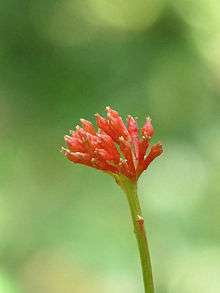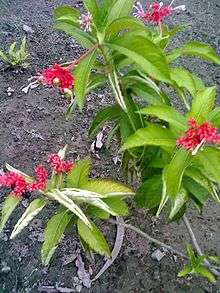Rauvolfia serpentina
| Rauvolfia serpentina | |
|---|---|
 | |
| Scientific classification | |
| Kingdom: | Plantae |
| (unranked): | Angiosperms |
| (unranked): | Eudicots |
| (unranked): | Asterids |
| Order: | Gentianales |
| Family: | Apocynaceae |
| Genus: | Rauvolfia |
| Species: | R. serpentina |
| Binomial name | |
| Rauvolfia serpentina (L.) Benth. ex Kurz[1] | |
| Synonyms[2] | |
| |

Rauvolfia serpentina, or Indian snakeroot is a species of flower in the family Apocynaceae. It is native to the Indian subcontinent and East Asia (from India to Indonesia).[3][4] Common English names include devil pepper and snakeroot.
Vernacular names
English: serpentine wood[5] Bengali: Chandra; Hindi: Chandrabagha, Chota chand; Kannada: Patalagondhi, Sarpagandhi,Shivavabhiballi, Sutranavi; Malayalam: Chuvanna-vilpori, Suvapavalforiyan; Marathi: Harkaya, Harki; Oriya:Patalgarur, Sanochada; Tamil: Chivan amelpodi; Telgu: Paataala garuda, Paataala goni; Urdu: Asrel.[6] indonesia : pule pandak;
Chemical composition
Rauvolfia serpentina The plant contains 200 alkaloids of the indole alkaloid family. SerpentinaDB The major alkaloids are ajmaline, ajmalicine, ajmalimine, deserpidine, indobine, indobinine, reserpine, reserpiline, rescinnamine, rescinnamidine, serpentine, serpentinine and yohimbine.[7]
Medicinal uses
The extract of the plant has been used for millennia in India – Alexander the Great administered this plant to cure his general Ptolemy I Soter of a poisoned arrow. It was reported that Mahatma Gandhi took it as a tranquilizer during his lifetime.[8] It has been used to treat insect stings and the bites of venomous reptiles. The plant also contains reserpine, was used to treat high blood pressure and mental disorders including schizophrenia, and had a brief period of popularity for that purpose in the West from 1954 to 1957.[9] R. serpentina is also known for its antimicrobial, antifungal, anti-inflammatory, antiproliferative, antidiuretic and anticholinergic activities.[7]
Recent research has proved that Rauwolfia serpentina exhibits activity against drug-resistant tumor cells.[10]
It is one of the 50 fundamental herbs used in traditional Chinese medicine, where it has the name shégēn mù (Chinese: 蛇根木) or yìndù shémù (Chinese: 印度蛇木).
Other uses
The wood, commonly known as serpentwood, is mildly popular amongst woodcarving and woodturning hobbyists.
See also
References
| Wikimedia Commons has media related to Rauvolfia serpentina. |
- ↑ "Module 11: Ayurvedic". Retrieved 2008-02-11.
- ↑ "The Plant List: A Working List of All Plant Species". Retrieved 12 April 2015.
- ↑ eFloras. "Rauvolfia serpentina". Flora of China. Missouri Botanical Garden, St. Louis, MO & Harvard University Herbaria, Cambridge, MA. Retrieved 9 April 2012.
- ↑ Oudhia, P. and Tripathi, R.S. (2002). Identification, cultivation and export of important medicinal plants. In Proc. National Seminar on Horticulture Development in Chhattisgarh: Vision and Vistas. Indira Gandhi Agricultural University, Raipur (India) 21-23 Jan. 2002:78-85.
- ↑ "Rauvolfia serpentina". Natural Resources Conservation Service PLANTS Database. USDA. Retrieved 19 October 2015.
- ↑ http://www.bsienvis.nic.in/CITES/R.%20serpentina.pdf
- 1 2 http://www.globalresearchonline.net/journalcontents/v23-2/56.pdf
- ↑ Pills for Mental Illness?, TIME Magazine, November 8, 1954
- ↑ Sumit Isharwal and Shubham Gupta (2006). "Rustom Jal Vakil: his contributions to cardiology". Texas Heart Institute Journal. 33 (2): 161–170. PMC 1524711
 . PMID 16878618.
. PMID 16878618. - ↑ "Cytotoxicity of the indole alkaloid reserpine from Rauwolfia serpentina against drug-resistant tumor cells". Phytomedicine. 22: 308–318. doi:10.1016/j.phymed.2015.01.002.